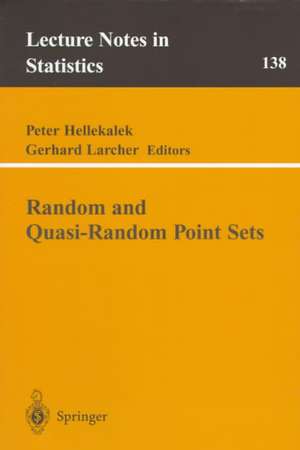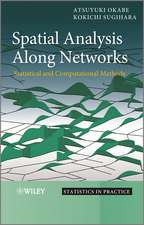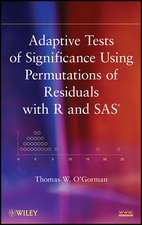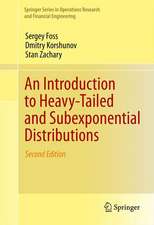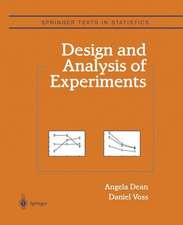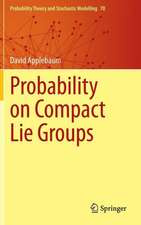Random and Quasi-Random Point Sets: Lecture Notes in Statistics, cartea 138
Editat de Peter Hellekalek Contribuţii de J. Beck Editat de Gerhard Larcher Contribuţii de P. Hellekalek, P. Hickernell, G. Larcher, P. L'Ecuyer, H. Niederreiter, S. Tezuka, C. Xingen Limba Engleză Paperback – 9 oct 1998
Din seria Lecture Notes in Statistics
- 15%
 Preț: 631.86 lei
Preț: 631.86 lei -
 Preț: 385.84 lei
Preț: 385.84 lei - 17%
 Preț: 490.20 lei
Preț: 490.20 lei - 17%
 Preț: 460.30 lei
Preț: 460.30 lei - 18%
 Preț: 945.92 lei
Preț: 945.92 lei - 20%
 Preț: 561.44 lei
Preț: 561.44 lei - 18%
 Preț: 943.25 lei
Preț: 943.25 lei - 18%
 Preț: 943.25 lei
Preț: 943.25 lei - 18%
 Preț: 990.57 lei
Preț: 990.57 lei - 15%
 Preț: 641.38 lei
Preț: 641.38 lei -
 Preț: 428.67 lei
Preț: 428.67 lei - 15%
 Preț: 633.53 lei
Preț: 633.53 lei - 15%
 Preț: 658.88 lei
Preț: 658.88 lei -
 Preț: 383.33 lei
Preț: 383.33 lei - 15%
 Preț: 640.71 lei
Preț: 640.71 lei - 18%
 Preț: 947.18 lei
Preț: 947.18 lei - 18%
 Preț: 1007.35 lei
Preț: 1007.35 lei - 18%
 Preț: 942.63 lei
Preț: 942.63 lei - 15%
 Preț: 639.59 lei
Preț: 639.59 lei - 18%
 Preț: 1231.47 lei
Preț: 1231.47 lei - 15%
 Preț: 643.00 lei
Preț: 643.00 lei - 18%
 Preț: 886.62 lei
Preț: 886.62 lei -
 Preț: 383.12 lei
Preț: 383.12 lei - 15%
 Preț: 633.35 lei
Preț: 633.35 lei - 15%
 Preț: 635.65 lei
Preț: 635.65 lei -
 Preț: 393.74 lei
Preț: 393.74 lei - 15%
 Preț: 632.70 lei
Preț: 632.70 lei - 15%
 Preț: 637.28 lei
Preț: 637.28 lei - 15%
 Preț: 702.87 lei
Preț: 702.87 lei - 15%
 Preț: 642.68 lei
Preț: 642.68 lei - 15%
 Preț: 644.63 lei
Preț: 644.63 lei - 15%
 Preț: 645.14 lei
Preț: 645.14 lei -
 Preț: 382.36 lei
Preț: 382.36 lei - 15%
 Preț: 636.30 lei
Preț: 636.30 lei - 15%
 Preț: 647.92 lei
Preț: 647.92 lei -
 Preț: 380.63 lei
Preț: 380.63 lei - 18%
 Preț: 887.05 lei
Preț: 887.05 lei - 15%
 Preț: 634.32 lei
Preț: 634.32 lei - 15%
 Preț: 648.74 lei
Preț: 648.74 lei -
 Preț: 378.92 lei
Preț: 378.92 lei - 15%
 Preț: 648.56 lei
Preț: 648.56 lei - 15%
 Preț: 647.59 lei
Preț: 647.59 lei - 18%
 Preț: 780.37 lei
Preț: 780.37 lei - 15%
 Preț: 641.20 lei
Preț: 641.20 lei - 18%
 Preț: 1102.69 lei
Preț: 1102.69 lei - 15%
 Preț: 643.16 lei
Preț: 643.16 lei -
 Preț: 384.70 lei
Preț: 384.70 lei
Preț: 642.83 lei
Preț vechi: 756.27 lei
-15% Nou
Puncte Express: 964
Preț estimativ în valută:
123.01€ • 131.54$ • 102.56£
123.01€ • 131.54$ • 102.56£
Carte tipărită la comandă
Livrare economică 18 aprilie-02 mai
Preluare comenzi: 021 569.72.76
Specificații
ISBN-13: 9780387985541
ISBN-10: 0387985549
Pagini: 334
Ilustrații: XII, 334 p. 9 illus.
Dimensiuni: 155 x 235 x 18 mm
Greutate: 0.49 kg
Ediția:Softcover reprint of the original 1st ed. 1998
Editura: Springer
Colecția Springer
Seria Lecture Notes in Statistics
Locul publicării:New York, NY, United States
ISBN-10: 0387985549
Pagini: 334
Ilustrații: XII, 334 p. 9 illus.
Dimensiuni: 155 x 235 x 18 mm
Greutate: 0.49 kg
Ediția:Softcover reprint of the original 1st ed. 1998
Editura: Springer
Colecția Springer
Seria Lecture Notes in Statistics
Locul publicării:New York, NY, United States
Public țintă
ResearchCuprins
From Probabilistic Diophantine Approximation to Quadratic Fields.- 1 Part I: Super Irregularity.- 2 Part II: Probabilistic Diophantine Approximation.- 3 Part III: Quadratic Fields and Continued Fractions.- 4 Part IV: Class Number One Problems.- 5 Part V: Cesaro Mean of % MathType!MTEF!2!1!+-% feaagCart1ev2aaatCvAUfeBSjuyZL2yd9gzLbvyNv2CaerbuLwBLn% hiov2DGi1BTfMBaeXatLxBI9gBaerbd9wDYLwzYbItLDharqqtubsr% 4rNCHbGeaGqiVu0Je9sqqrpepC0xbbL8F4rqqrFfpeea0xe9Lq-Jc9% vqaqpepm0xbba9pwe9Q8fs0-yqaqpepae9pg0FirpepeKkFr0xfr-x% fr-xb9adbaqaaeGaciGaaiaabeqaamaabaabaaGcqaaaaaaaaaWdbe% aadaaeqaWdaeaapeWaaeWaa8aabaWdbmaacmaapaqaa8qacaWGUbGa% eqySdegacaGL7bGaayzFaaGaeyOeI0IaaGymaiaac+cacaaIYaaaca% GLOaGaayzkaaaal8aabaWdbiaad6gaaeqaniabggHiLdaaaa!42C9!$$ \sum\nolimits_n {\left( {\left\{ {n\alpha } \right\} - 1/2} \right)} $$.- 6 References.- On the Assessment of Random and Quasi-Random Point Sets.- 1 Introduction.- 2 Chapter for the Practitioner.- 3 Mathematical Preliminaries.- 4 Uniform Distribution Modulo One.- 5 The Spectral Test.- 6 The Weighted Spectral Test.- 7 Discrepancy.- 8 Summary.- 9 Acknowledgements.- 10 References.- Lattice Rules: How Well Do They Measure Up?.- 1 Introduction.- 2 Some Basic Properties of Lattice Rules.- 3 A General Approach to Worst-Case and Average-Case Error Analysis.- 4 Examples of Other Discrepancies.- 5 Shift-Invariant Kernels and Discrepancies.- 6 Discrepancy Bounds.- 7 Discrepancies of Integration Lattices and Nets.- 8 Tractability of High Dimensional Quadrature.- 9 Discussion and Conclusion.- 10 References.- Digital Point Sets: Analysis and Application.- 1 Introduction.- 2 The Concept and Basic Properties of Digital Point Sets.- 3 Discrepancy Bounds for Digital Point Sets.- 4 Special Classes of Digital Point Sets and Quality Bounds.- 5 Digital Sequences Based on Formal Laurent Series and Non-Archimedean Diophantine Approximation.- 6 Analysis of Pseudo-Random-Number Generators by Digital Nets.- 7 The Digital Lattice Rule.- 8 Outlook and Open Research Topics.- 9 References.- Random Number Generators: Selection Criteria and Testing.- 1 Introduction.- 2 Design Principles and Figures of Merit.- 3 Empirical Statistical Tests.- 4 Examples of Empirical Tests.- 5 Collections of Small RNGs.- 6 Systematic Testing for Small RNGs.- 7 How Do Real-Life Generators Fare in These Tests?.- 8 Acknowledgements.- 9 References.- Nets, (ts)-Sequences, and Algebraic Geometry.- 1 Introduction.- 2 Basic Concepts.- 3 The Digital Method.- 4 Background on Algebraic Curves over Finite Fields.- 5 Construction of (ts)-Sequences.- 6 New Constructions of (tms)-Nets.- 7 New Algebraic Curves with Many Rational Points.- 8 References.- Financial Applications of Monte Carlo and Quasi-Monte Carlo Methods.- 1 Introduction.- 2 Monte Carlo Methods for Finance Applications.- 3 Speeding Up by Quasi-Monte Carlo Methods.- 4 Future Topics.- 5 References.
